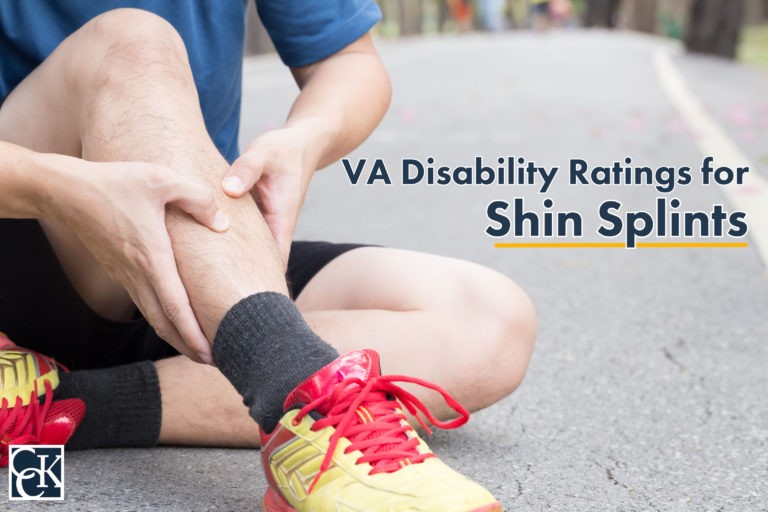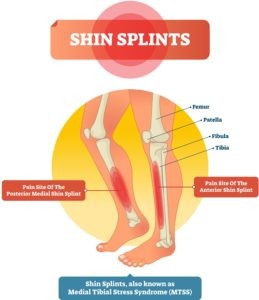VA Disability Ratings for Shin Splints

Shin splints are a common condition that can affect a veteran’s lower extremities. Veterans may qualify for VA disability benefits if they can prove that the condition was caused by military service.
What are Shin Splints?
Shin splints, or medial tibial stress syndrome, occurs when stress is placed on the shinbone and the tissues which attach muscles to the bones. These tissues can become inflamed and painful.
There are many common causes. Oftentimes, exercise can cause shin splints, especially working out without a warm-up or adequate cool-down stretch. Wearing shoes that do not fit well or that do not provide good support can also cause the condition, particularly when wearing those shoes for long periods of time. Physical conditions, such as weak ankles, hips, or core muscles, as well as flat feet, may also contribute to the development of this condition.
The likelihood of developing shin splints from physical activity, such as that required throughout military service, can increase if the person makes sudden changes like increased intensity, or more frequent and longer workouts. While shin splits typically heal on their own with time, there are a few ways to ease the pain.
Treating Shin Splints
Though shin splits do typically heal on their own, a doctor may do a physical exam to determine if there are graver injuries, such as fractures. A doctor may take X-rays or bone scans to look for these fractures.
Other ways to ease the pain associated with shin splints include:
- Rest
- Icing the shin to alleviate pain and reduce swelling
- Using insoles or orthotics in the shoes, which can help with flat feet
- Medication, such as pain relievers, as needed
Establishing VA Service Connection for Shin Splints
Shin splints are eligible for service connection and are assessed as knee and lower leg conditions. Shin splints are considered a compensable condition by VA, specifically when they result in the limitation of ordinary function or range of motion.
In order to become service-connected for shin splints, the veteran will need to provide three things:
- A current diagnosis that is noted in the veteran’s medical record,
- A description of how the veteran’s service contributed or caused the shin splints, and
- A medical nexus linking the current, diagnosed shin splints to service.
The shin splints must be a current and ongoing condition in order for the veteran to receive disability compensation benefits from VA. In other words, if the veteran previously experienced shin splints, but no longer does, they will not be eligible for VA disability compensation benefits.
Compensation and Pension Exams (C&P) for Shin Splints
Once the veteran has filed a claim for shin splints, VA may request a Compensation and Pension (C&P) exam. It is important to follow up with scheduling the exam and to attend, otherwise, VA could deny the veteran’s claim.
The exam will be performed by a VA physician or a VA-contracted physician. Before the exam, the examiner will review the veteran’s c-file, which contains the veteran’s medical and service records. During the exam, the examiner may ask the veteran questions about their shin splints or their service. They may also physically examine the veteran.
The veteran may also use a DBQ, or Disability Benefits Questionnaire, to bolster their claim. A Disability Benefits Questionnaire is a form created by VA so that the veteran may address important aspects of their condition, such as symptoms, severity, possible causes, and relation to other disabilities. For shin splints, veterans may use the Disability Benefits Questionnaire for knee and lower leg conditions.
Most times, shin splints are rated on how they affect the veteran’s range of motion. In these cases, the examiner may use a tool called a goniometer to obtain an accurate measurement of range of motion.
How VA Rates Shin Splints for Disability Benefits
As mentioned above, shin splints are rated as a knee and lower leg condition. Specifically, shin splints are rated under 38 C.F.R. § 4.71a, Diagnostic Code (DC or Code) 5262. This Diagnostic Code is specifically used for the impairment of the tibia and fibula. The tibia is a large bone located in the lower front of the leg. The fibula is a smaller bone that paired with the tibia in the lower part of the leg.
Below are the criteria for the different ratings given to veterans’ shin splints:
- 0% – This rating is assigned to veterans who have been receiving treatment for less than 12 consecutive months. The shin splints may affect one or both legs.
- 10% – Veterans can receive a 10 percent rating if they have been receiving treatment for at least 12 consecutive months, and the shin splints have been unresponsive to either shoe orthotics or other conservative treatment. One or both legs may be affected.
- 20% – The 20 percent rating is assigned to veterans who have received treatment for at least 12 consecutive months, with shin splints that have been unresponsive to surgery and either shoe orthotics or other conservative treatment. This rating is given in instances where the shin splints are affecting only one leg.
- 30% – The 30 percent rating is assigned to veterans who have received treatment for at least 12 consecutive months, and their condition has been unresponsive to surgery and either shoe orthotics or other conservative treatment. This rating is given in instances where the shin splints are affecting both legs.
Total Disability based on Individual Unemployability (TDIU)
Total disability based on individual unemployability, or TDIU, is a disability benefit that compensates veterans at the 100 percent level. This benefit is available to veterans who may not regularly meet the criteria needed to reach the 100 percent rating.
Although shin splints can only generate a maximum rating of 30 percent, veterans who are service-connected may be eligible to receive TDIU benefits. There are two pathways to become eligible for TDIU:
- 38 CFR § 4.16a (“Schedular”) – For this form of TDIU, the veteran must have:
- One condition rated at a minimum of 60 percent OR
- Two conditions combined to reach 70 percent, where one condition is rated at a minimum of 40 percent.
- 38 CFR § 4.16b (“Extraschedular”) – This form of TDIU is for veterans who may not be able to achieve the ratings necessary for schedular TDIU, but are still unable to obtain substantially gainful employment on account of their conditions. In this instance, the veteran must prove that their condition is uniquely hinders their ability to obtain substantially gainful employment and therefore should not be rated on the standard disability rating criteria.
The rating given for a veteran’s shin splints may be combined with another condition to help the veteran achieve the criteria for schedular TDIU.
Was Your VA Disability Claim Denied?
The process of being awarded disability benefits can be long and difficult to navigate. If your VA disability claim has been denied, the VA disability lawyers at Chisholm, Chisholm & Kilpatrick may be able to help. Contact our office at 800-544-9144 for a free consultation.
About the Author
Share this Post
